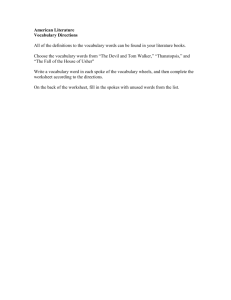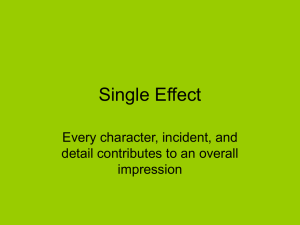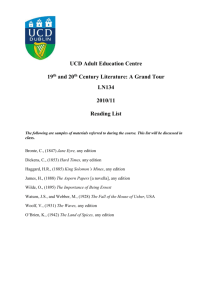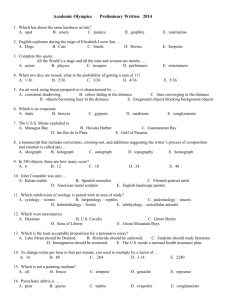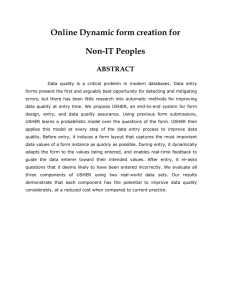Improving data quality with dynamic forms Please share
advertisement
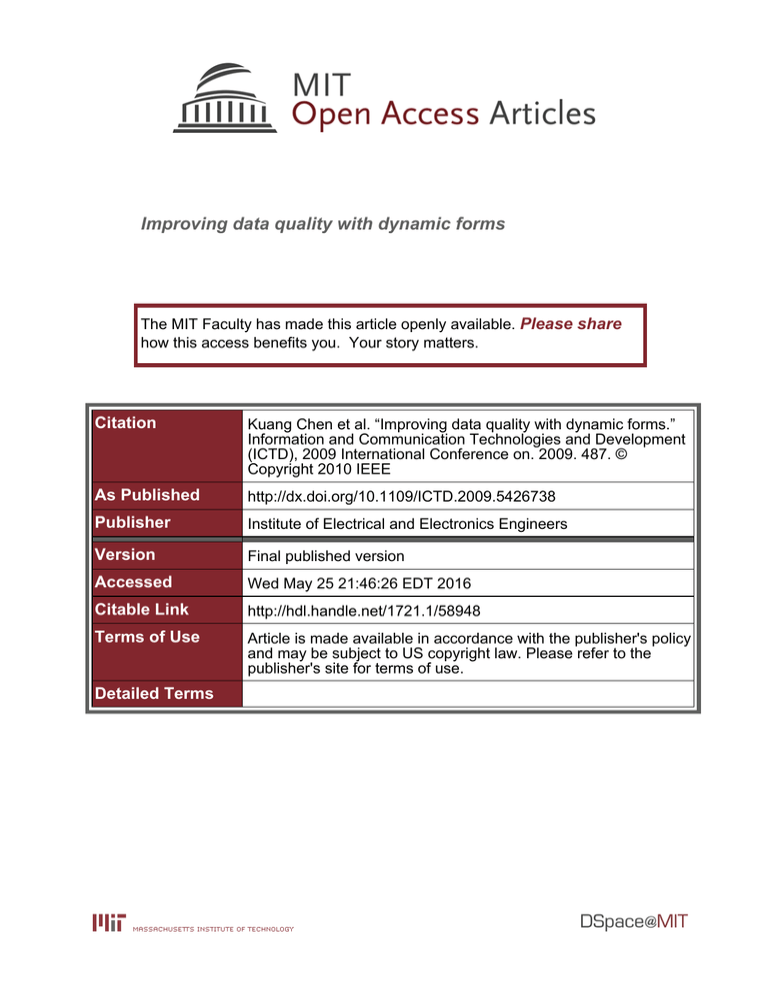
Improving data quality with dynamic forms
The MIT Faculty has made this article openly available. Please share
how this access benefits you. Your story matters.
Citation
Kuang Chen et al. “Improving data quality with dynamic forms.”
Information and Communication Technologies and Development
(ICTD), 2009 International Conference on. 2009. 487. ©
Copyright 2010 IEEE
As Published
http://dx.doi.org/10.1109/ICTD.2009.5426738
Publisher
Institute of Electrical and Electronics Engineers
Version
Final published version
Accessed
Wed May 25 21:46:26 EDT 2016
Citable Link
http://hdl.handle.net/1721.1/58948
Terms of Use
Article is made available in accordance with the publisher's policy
and may be subject to US copyright law. Please refer to the
publisher's site for terms of use.
Detailed Terms
487
Improving Data Quality With Dynamic Forms
Kuang Chen, Harr Chen, Neil Conway, Heather Dolan, Joseph M. Hellerstein, and Tapan S. Parikh
Abstract-Organizations in developing regions want to efficiently collect digital data, but standard data gathering practices
from the developed world are often inappropriate. Traditional
techniques for form design and data quality are expensive and
labour-intensive. We propose a new data-driven approach to form
design, execution (filling) and quality assurance. We demonstrate
USHER, an end-to-end system that automatically generates data
entry forms that enforce and maintain data quality constraints
during execution. The system features a probabilistic engine that
drives form-user interactions to encourage correct answers.
I. INTRODUCTION
Governments, companies, and individuals routinely make
important decisions based on inaccurate data stored in supposedly authoritative databases. In healthcare, a simple error may
have fatal consequences. While data quality can be addressed
at every stage of the data life-cycle, from creation to archival,
we believe that entry-time is the first and best opportunity to
improve the quality of manually-entered data. There is much
prior work on improving the quality of data that already resides
in a database [1]. However, relatively little attention has been
paid to improved techniques for data entry.
Survey design [2] has long informed the design of data entry
forms, applying principles for data encodings, constraints,
and validation rules. For electronic forms, quality assurance
during entry has centered on the ubiquitous and costly practice
of double-entry [3]. Current standards have failed to take
advantage of new technology: pervasive cellular networking
and low-cost mobile devices allows even remote users to
interact with data entry systems that could potentially provide
rich feedback.
For organizations with limited resources, existing standards
are neither practical nor attainable. In such settings, designing
data collection instruments is too often an ad hoc practice,
consisting of mapping desired information elements to a set
of entry widgets (text fields, combo boxes, etc.), guided only
by the designer's intuition. According to recent work on data
collection in resource-poor settings, lack of expertise and
difficulty of remote data collection are the chief obstacles
to high data quality [4]. In our previous fieldwork with a
well-funded HIV/AIDS treatment program in East Africa, we
found that little thought was given to form design, and a
haphazard double-entry program bottlenecked the data entry
process to a substantial degree; in fact, the program's health
K. Chen, N. Conway and 1. M. Hellerstein are with the Computer
Science Division, University of California at Berkeley (email: {kuangc, nrc,
hellerstein}@cs.berkeley.edu).
H. Chen is with the Computer Science and Artificial Intelligence Laboratory, Massachusetts Institute of Technology (email: harr@csail.mit.edu)
H. Dolan and T. S. Parikh are with the School of Information, University
of California at Berkeley (email: {dolan, parikh}@ischool.berkeley.edu)
Manuscript accepted Feb 10, 2009.
clinic operations were limited to using paper forms to ensure
timely information access. Only after a labor-intensive delay
did the medical researchers enjoy the benefits of digital data
for research and analysis.
We have built a system called USHER that maximizes data
quality at entry-time using statistical data modeling, dynamic
interfaces, and collaborative insight. Guided by prior data,
USHER learns probabilistic relationships in the data to train a
model, which is then applied to automatically generate forms
with the appropriate constraints. USHER then provides realtime feedback during the data entry process to dynamically
guide (or usher) the user toward better data quality.
Based on a list of form questions and a sufficient set
of answers, USHER optimizes the form's question-ordering
and layout, mimicking survey design principles. During form
entry, USHER provides dynamic data-quality feedback to the
user. When the user enters a value, USHER automatically
decorates the interface with hints and warnings if the answer
is deemed "risky." Decoration choices are probabilistically
guided, and include auto-complete, correctness-thermometers,
warning/error flags, and other scented widgets [5]. USHER
also invites the user to write and view comments about
form questions or data instances for and by other users.
Finally, USHER mimics double-entry by choosing to re-ask
questions with responses likely to be erroneous, based on the
probabilistic model.
II. DEMONSTRATION
Our demonstration will show USHER'S ability to approximate expert form design and double-entry based only on prior
data, both on a PC and a mobile device. Using a real dataset
from a rural health organization, users will be able to 1)
automatically extract training data from a Microsoft Access
database; 2) refine the automatically designed form; and 3)
execute the forms with and without smart decorations and
quality assurance.
REFERENCES
[1] 1. M. Hellerstein,
"Quantitative data cleaning for large databases," United
Nations Economic Commission for Europe, 2008.
[2] R. M. Graves, F. 1. Fowler, M. P. Couper, J. M. Lepkowski, E. Singer,
and R. Tourangeau, Survey Methodology. Wiley-Interscience, 2004.
[3] S. Day, P. Fayers, and D. Harvey, "Double data entry: what value, what
price?" Controlled Clinical Trials, 1998.
[4] 1. V. D. Broeck, M. Mackay, N. Mpontshane, A. K. K. Luabeya,
M. Chhagan, and M. L. Bennish, "Maintaining data integrity in a rural
clinical trial," Controlled Clinical Trials, 2007.
[5] W. Willett, "Scented widgets: Improving navigation cues with embedded
visualizations," IEEE TVCG, 2007.


